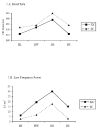Kangaroo Care modifies preterm infant heart rate variability in response to heel stick pain: pilot study
- PMID: 19505775
- PMCID: PMC2742959
- DOI: 10.1016/j.earlhumdev.2009.05.012
Kangaroo Care modifies preterm infant heart rate variability in response to heel stick pain: pilot study
Abstract
Background: Heel stick is the most common painful procedure for preterm infants in neonatal intensive care units. Resultant pain causes adverse physiological effects in major organ systems. Kangaroo Care (KC), involving mother-infant skin-to-skin contact is a promising analgesic for infant pain; however, the effect of KC on the autonomic nervous system's response to pain is unknown.
Aim: To determine if KC results in improved balance in autonomic responses to heel stick pain than the standard method where infants remain in an incubator care (IC) for the heel stick.
Study design: A randomized cross-over trial.
Subjects: Fourteen preterm infants, 30-32 weeks gestational age and less than 9 days postnatal age.
Outcome measures: Infant behavioral state, heart rate, heart rate variability (HRV) indices including low frequency (LF) and high frequency (HF) power, and the LF/HF ratio measured over Baseline, Heel Warming, Heel Stick, and Recovery periods in KC and IC conditions.
Results: HRV differences between KC and IC were that LF was higher in KC at Baseline (p<.01) and at Heel Stick (p<.001), and HF was higher in KC at Baseline than in the IC condition (p<.05). The LF/HF ratio had less fluctuation across the periods in KC than in IC condition and was significantly lower during Recovery in KC than in IC (p<.001).
Conclusions: Infants experienced better balance in response in KC than IC condition as shown by more autonomic stability during heel stick. KC may be helpful in mediating physiologic response to painful procedures in preterm infants.
Conflict of interest statement
Figures



References
-
- Stevens B, McGrath P, Gibbins S, Beyene J, Breau L, Camfield C, et al. Procedural pain in newborns at risk for neurologic impairment. Pain. 2003 Sep;105(12):27–35. - PubMed
-
- Simons SH, van Dijk M, Anand KS, Roofthooft D, van Lingen RA, Tibboel D. Do we still hurt newborn babies? A prospective study of procedural pain and analgesia in neonates. Arch Pediatr Adolesc Med. 2003 Nov;157(11):1058–64. - PubMed
-
- Porter FL, Anand KJS. Epidemiology of pain in neonates. Research & Clinical Forums. 1998;20:9–16.
-
- Evans JC, McCartney EM, Lawhon G, Galloway J. Longitudinal comparison of preterm pain responses to repeated heelsticks. Pediatr Nurs. 2005 May-Jun;31(3):216–21. - PubMed
Publication types
MeSH terms
Grants and funding
LinkOut - more resources
Full Text Sources
Medical
Research Materials
Miscellaneous

